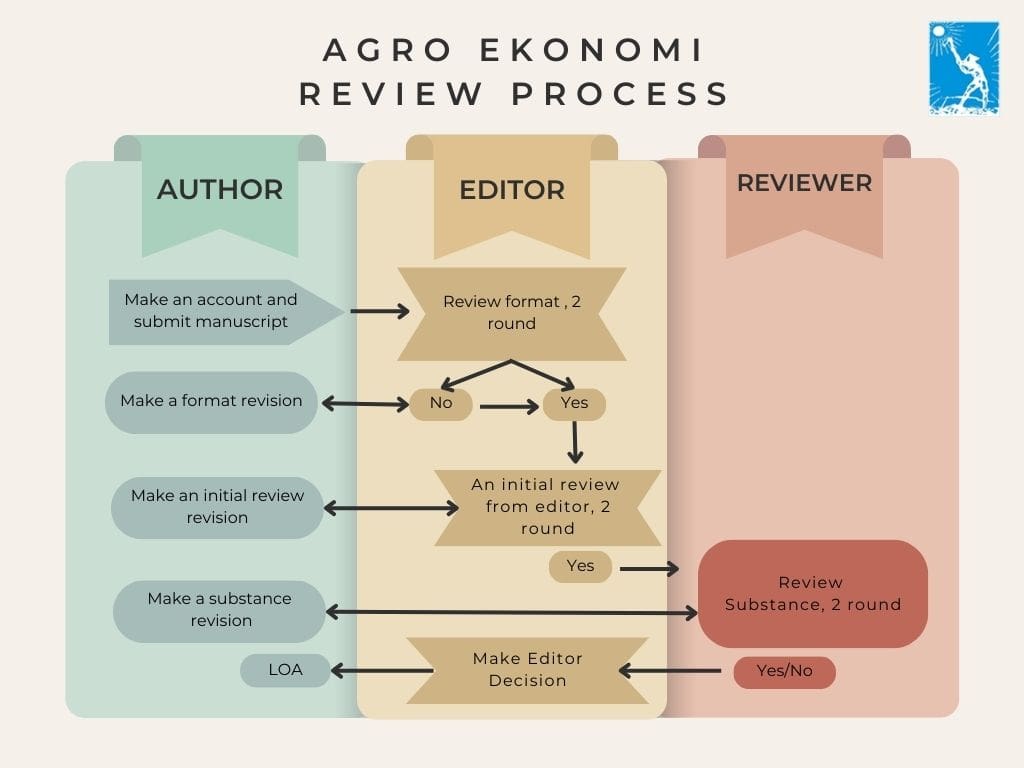Patterns and Determinant Factors Of Arabica Coffee’s Marketing Margin In Ngada Regency
Maria Clara Mau(1*), Dwidjono Hadi Darwanto(2), Masyhuri Masyhuri Masyhuri(3)
(1) Magister Management of Agribusiness , Faculty of Agriculture, Universitas Gadjah Mada
(2) Magister Management of Agribusiness , Faculty of Agriculture, Universitas Gadjah Mada
(3) Magister Management of Agribusiness , Faculty of Agriculture, Universitas Gadjah Mada
(*) Corresponding Author
Abstract
Coffee is one of the essential plantation commodities in the development process of plantation sub-sector. Ngada Regency is one of the coffee producers in East Nusa Tenggara Province. Coffee in Ngada Regency becomes one of the plantation commodities that conceive high potential to be developed. This research aims to discover the established marketing channel pattern, factors influencing marketing margin of Arabica coffee, and the quantity of price received by farmers the in Ngada Regency. The respondents in this research were 59 farmers who were derived randomly and 10 merchants who were derived from snowball sampling technique. This research used interview with a questionnaire as supporting tools in collecting the data. This research analyzed the data descriptively and multiple regression analysis was also conducted through Ordinary Least Square method. The analysis results show that (1) the established marketing channel pattern of Arabica coffee in Ngada Regency are channel I: Farmers - Product Processing Unit – PT. Indocom (sold in the form of red logs coffee that is processed into Hard Skin coffee), channel II: Farmers – PT. Indocom (sold in the form of Hard Skin coffee) and channel III: Farmers – Collected Traders – Retailers – Consumer (sold in the form of coffee beans). (2) The factors that influence the marketing margin are marketing volume and marketing cost. The distance and coffee processing do not have any significant influence towards the marketing margin. (3) The marketing channel that conceives high value of farmer’s share is the marketing channel II.
Keywords
Full Text:
PDFReferences
Asmarantaka, R. W. (2012). Agrimarketing. Bogor: Departemen Agribisnis, Fakultas Ekonomi dan Manajemen, Institut Pertanian Bogor.
Budiningsih, S., & Utami, P. (2007). Analisis Efisiensi Saluran Pemasaran Salak Pondoh (Studi Kasus di Desa Sigaluh Kecamatan Sigaluh Banjarnegara). Agritech, IX(1), 94–108.
Chaerani, D. S. (2016). Margin Dan Efisiensi Pemasaran Kopra Di Desa Simalegi. Jurnal Bibiet, 1(2), 81–94.
Desiana, C. (2017). Analisis Saluran Pemasaran Biji Kopi Robusta. Jurnal Agroinfo Galuh, 4(2), 162–173.
Dina, N. D. (2015). Analisis Pemasaran Biji Kakao di Kecamatan Kalibawang Kabupaten Kulon Progo. Universitas Gadjah Mada.
Hartatri, D. F. S., & de Rosari, B. (2011). Analisis Usahatani dan Rantai Pemasaran Kopi Arabika di Kabupaten Manggarai dan Manggarai Timur. Jurnal Pelita Perkebunan, 27(1), 55–67.
Kozlenkova, I. V, Hult, G. T. M., Lund, D. J., Mena, J. A., & Kekec, P. (2015). The Role of Marketing Channels in Supply Chain Management. Journal of Retailing, 91(4), 586–609. https://doi.org/10.1016/j.jretai.2015.03.003
Lestari, O., Hasyim, A. I., & Kasymir, E. (2017). Analisis Usahatani dan Efisiensi Pemasaran Kopi di Kecamatan Pulau Panggung Kabupaten Tanggamus. JIIA, 5(1), 1–8.
Ministry of Agriculture. (2016). Outlook Kopi Komoditas Pertanian Subsektor Perkebunan. Pusat Data Dan Sistem Informasi Pertanian Sekretariat Jenderal.
Mukhsin, M. (2017). Pengaruh Kepercayaan dan Komitmen Terhadap Rantai Kualitas Hubungan Dampaknya Pada Kinerja Rantai Pasokan ( Studi Kasus Produksi dan Distribusi Dedak pada PD Sederhana ). Jurnal Manajemen, XXI(3), 454–471.
Mustadjab, M. M., Setiawan, B., & Pamungkas, C. (2008). Analisis Pemasaran Beras dalam Upaya Peningkatan Pendapatan Petani. Agrise, VIII(1), 23–38.
Oktora, S., & Dewanto, H. (2011). Kopi Manggarai yang Merana. Retrieved from https://ekonomi.kompas.com/read/2011/04/21/05331345/kopi.manggarai.yang.merana
Pobela, H. (2016). Analisis Pemasaran Kopi Di Desa Bilalang Kecamatan Bilalang Kabupaten Bolaang Mongondow. E-Jurnal Sariputra, 3(1), 26–31.
Rahmania, H. (2017). Analisis Usahatani Kopi Di Desa Pirian Tapiko Kecamatan Tutar Kabupaten Polewali Mandar. Prosiding Kajian Ilmiah Dosen.
Sairdama, S. S. (2013). Analisis Pendapatan Petani Kopi Arabika ( Coffea arabica ) dan Margin Pemasaran di Distrik Kamu Kabupaten Dogiyai. Jurnal Agribisnis Kepulauan, 2(2), 44–56.
Sega, K. E. (2012). Perbedaan Cara Pemasaran Kacang Tanah di Desa Tamansari Kecamatan Tlogowungu Kabupaten Pati. Jurnal Agromedia, 30(2), 35–49.
Sujiwo, J. T. (2009). Efisiensi Pemasaran Kopi (Coffea sp) di Kecamatan Singorojo Kabupaten Kendal. Jurnal Ilmu-Ilmu Pertanian, 5(2), 72–85.
Widati, A. W. (2011). Analisis Keterpaduan Pasar Beras di Kabupaten Manokwari. Jurnal Agro Ekonomi, 1(1), 51–60.
Yuniarti, D. (2017). Saluran Pemasaran Beras Organik di Kabupaten Boyolali. Agrisocionomics, 1(2), 106–114.
Zhou, Y., Zhang, X., Zhuang, G., & Zhou, N. (2015). Relational Norms and Collaborative Activities: Roles in Reducing Opportunism in Marketing Channels. Industrial Marketing Management, 46, 147–159.
Article Metrics
Refbacks
- There are currently no refbacks.
Copyright (c) 2018 Agro Ekonomi

This work is licensed under a Creative Commons Attribution-ShareAlike 4.0 International License.
View My Stats











